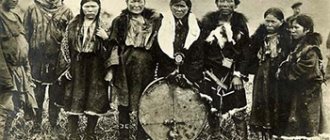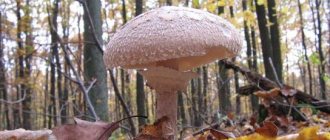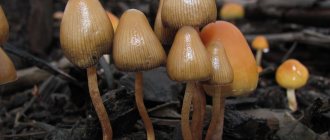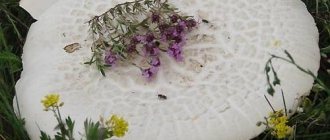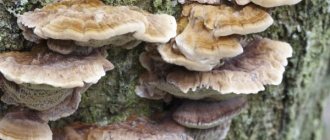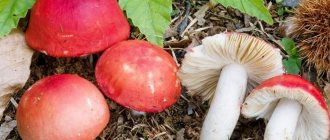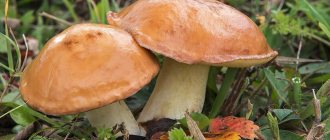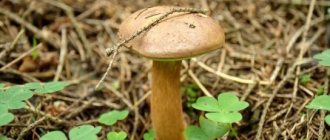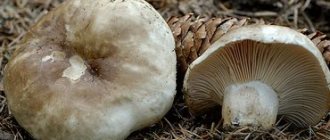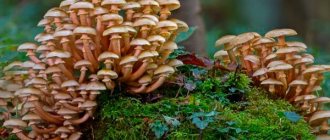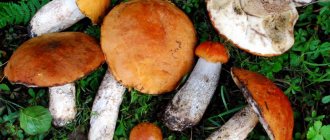Mushrooms
0
1742
Article rating
Kira Stoletova
Russula mushroom is often found in our forests. It is harvested all summer, but the peak yield still occurs in early autumn. There are about 270 types of russula, most of them are edible. Only some cannot be eaten because of their inherent bitter taste or toxicity. In terms of taste, the mushroom belongs to category 3 and has beneficial properties.
Popular russula mushroom
Description
Blue-yellow russula (Russula cyanoxantha), which is also called blue-green, has characteristic species differences:
- the cap is smooth with uneven coloring, combining bluish-green, violet-gray, ocher, pink and purple areas with smooth color transitions. With age, the convex hemispherical shape becomes flat with a depression in the center. After rain, the skin becomes sticky and shiny; it can be easily removed approximately 2/3 of the radius. Cap diameter - from 5 to 16 cm;
- the plates are whitish, narrowly adherent to the stem, frequent, flexible, not fragile, oily to the touch;
- white spores;
- The thick cylindrical leg is dense in young specimens and later becomes hollow. The color is white, often with a purple tint. Length from 5 to 10 cm, thickness - from 1 to 3 cm;
- The color of the dense but brittle flesh is white, under the skin of the cap it is reddish-purple, and in the stem it is cotton-like. The pulp does not darken when broken or cut, without any particular smell, the taste is light mushroom or nutty.
This species belongs to valuable edible mushrooms.
Features of mushrooms
Russulas belong to the lamellar mushrooms. A description of the features inherent in most species is as follows:
- Young mushrooms have spherical or bell-shaped caps, then they become flat, funnel-shaped or convex. They have straight, curved, and sometimes ribbed edges. The caps break easily, which reduces the value of the mushrooms.
- The skin can be dry and matte, less often wet and shiny. For most, it separates well from the pulp along the edges. Its color depends on the type of mushroom.
- The plates are usually dense, white or yellowish. They are straight in shape, with blunt or sharp edges.
- The leg is white, evenly cylindrical in shape, in some species it is thickened or pointed at the bottom. Usually it is dense, sometimes hollow from the inside.
- The pulp is dense and fragile. In old mushrooms it can be spongy and crumble easily.
- The color of the spore powder varies from white to yellow.
The first russula appear in July and grow at the end of summer. They grow under deciduous trees: birch, oak, alder and others. They can often be seen under pine and spruce trees. This type of fungus forms mycorrhiza with woody roots.
Most russula are edible, only a few of them are classified as slightly toxic. They are prepared in different ways: fried, salted, pickled. These mushrooms are quite healthy; they contain vitamins B and PP.
Russulas grow in Eurasia, Australia, North America and East Asia. There are 275 species of them in nature. Sometimes interspecific differences between them are almost invisible.
Distribution and fruiting period
Blue-yellow russula is found in forests of various regions of the northern temperate zone, mountain and lowland, growing singly and in groups. Prefers acidic soils. Inhabits pine forests, deciduous groves and mixed forests. The fruiting bodies ripen from the beginning of summer until the first days of November.
Collection rules
In adulthood, with the cap open, the forked russula is very fragile. A wide basket or bucket is suitable for collecting them; in a plastic bag or backpack they will quickly turn into dust. Increased fragility is due to the presence of special vesicular cells in the fruiting body, called spherocysts.
Young, not overgrown specimens are suitable for food. Old mushrooms accumulate harmful substances and can be dangerous to humans. Collecting forked russula and other species near industrial enterprises and highways is fraught with poisoning.
The mushrooms are cut off together with the stem, checked for worms, then the cap is cut off and carefully placed in a basket with the plates facing down. In this position, they will remain clean, and spruce needles and other plant debris will not get stuck in them. This will make the reassembly job much easier. After harvesting, fork russulas retain their beneficial properties for 1-2 days, so they need to be processed and cooked immediately.
When going to the forest to pick mushrooms, you must take with you:
- a bottle of water and a snack (sandwiches);
- hydrogen peroxide and plaster;
- telephone (for calling 112);
- GPS navigator (if available);
- basket and knife.
Similar species
Blue-and-yellow russula can be confused with three edible relatives:
- glaucous (Russula palumbinal) with a violet-gray cap. Its main differences are white, fragile plates and a stem with a pinkish tint. This species grows more readily in deciduous forests.
- wine-red (Russula vinosa), colored in colors corresponding to the species name, growing mainly in pine forests; it is also distinguished by grayish-cream plates that darken with age;
- whole or wonderful (Russula integra), which has a cap of blood-red and brownish tones, yellowish and later gray plates and inhabits coniferous forests.
The conditionally edible brittle russula (Russula fragilis) is somewhat similar to the blue-yellow one, differing in a more uniform and rich brown-purple color of the cap and a pronounced pungent taste.
Taxonomy
Synonyms
- Agaricus furcatus var. heterophyllus Fr., 1821
- Agaricus galochrous Fr., 1815
- Agaricus heterophyllus (Fr.) Sacc., 1887
- Agaricus lividus Pers., 1801, nom. illeg.
- Russula furcata var. heterophylla (Fr.) P.Kumm., 1871
- Russula galochroa (Fr.) Fr., 1874
- Russula heterophylla f. galochroa (Fr.) Singer, 1923
- Russula heterophylla var. galocroa (Fr.) Gillet, 1876
- Russula heterophylla var. livida Gillet, 1876
- Russula heterophylla var. virginea (Cooke & Massee) A.Pearson & Dennis, 1948
- Russula livida (Gillet) J.Schröt., 1889
- Russula livida var. galochroa (Fr.) J. Schröt., 1889
- Russula livida var. virginea (Cooke & Massee) Melzer & Zvára, 1927
- Russula rigida Velen., 1920
- Russula virentirubens var. rigida (Velen.) Hornicek, 1988
- Russula virginea Cooke & Massee, 1890
Edibility
Edible blue-yellow russula is classified as category 3 mushrooms; its taste is especially appreciated in Europe. The species is suitable for consumption without prior boiling.
These mushrooms only need to be cleared of forest debris and washed. Then they can be stewed, fried and stored for future use - salted and pickled, added to soups.
Blue-yellow russula is a picturesque and widespread edible mushroom that is resistant to autumn cold. It is important to be able to distinguish it from less tasty conditionally edible relatives.
Excerpt characterizing Russula fork
It was already dark when Prince Andrei and Pierre arrived at the main entrance of the Lysogorsk house. While they were approaching, Prince Andrey with a smile drew Pierre's attention to the commotion that had occurred at the back porch. A bent old woman with a knapsack on her back, and a short man in a black robe and with long hair, seeing the carriage driving in, rushed to run back through the gate. Two women ran out after them, and all four, looking back at the stroller, ran into the back porch in fear. “These are the Machines of God,” said Prince Andrei. “They took us for their father.” And this is the only thing in which she does not obey him: he orders these wanderers to be driven away, and she accepts them. - What are God's people? asked Pierre. Prince Andrei did not have time to answer him. The servants came out to meet him, and he asked about where the old prince was and whether they were expecting him soon. The old prince was still in the city, and they were waiting for him every minute. Prince Andrei led Pierre to his half, which was always waiting for him in perfect order in his father’s house, and he himself went to the nursery. “Let’s go to my sister,” said Prince Andrei, returning to Pierre; - I haven’t seen her yet, she is now hiding and sitting with her God’s people. Serves her right, she will be embarrassed, and you will see God's people. C'est curieux, ma parole. [This is curious, honestly.] – Qu'est ce que c'est que [What are] God's people? – asked Pierre. “But you’ll see.” Princess Marya was really embarrassed and turned red in spots when they came to her. In her cozy room with lamps in front of icon cases, on the sofa, at the samovar, sat next to her a young boy with a long nose and long hair, and in a monastic robe. On a chair nearby sat a wrinkled, thin old woman with a meek expression on her childish face. – Andre, pourquoi ne pas m'avoir prevenu? [Andrey, why didn’t you warn me?] - she said with meek reproach, standing in front of her wanderers, like a hen in front of her chickens. – Charmee de vous voir. Je suis tres contente de vous voir, [Very glad to see you. “I’m so pleased that I see you,” she said to Pierre, while he kissed her hand. She knew him as a child, and now his friendship with Andrei, his misfortune with his wife, and most importantly, his kind, simple face endeared her to him. She looked at him with her beautiful, radiant eyes and seemed to say: “I love you very much, but please don’t laugh at mine.” After exchanging the first phrases of greeting, they sat down. “Oh, and Ivanushka is here,” said Prince Andrei, pointing with a smile at the young wanderer. – Andre! - Princess Marya said pleadingly. “Il faut que vous sachiez que c’est une femme, [Know that this is a woman,” Andrei said to Pierre. – Andre, au nom de Dieu! [Andrey, for God’s sake!] – repeated Princess Marya. It was clear that Prince Andrei’s mocking attitude towards the wanderers and Princess Mary’s useless intercession on their behalf were familiar, established relationships between them. “Mais, ma bonne amie,” said Prince Andrey, “vous devriez au contraire m'etre reconaissante de ce que j'explique a Pierre votre intimate avec ce jeune homme... [But, my friend, you should be grateful to me that I explain to Pierre your closeness to this young man.]
Greenish russula (scaly) and what can be done with them
Russula greenish (scaly) is perhaps the most delicious russula of all existing ones. It is subjected to absolutely all types of culinary processing. All types of preparations can be made from scaly russula, except for drying.
Family: Russulaceae.
Synonyms: scaly russula.
Description. The cap of the greenish russula is 5-12 cm in diameter, bluish-green, green, fleshy, with more or less rough, warty skin, cracking with age, thick, dry, tightly adherent skin. The plates are white or slightly yellowish. The pulp is very dense and fragile, with a pleasant taste and smell; when scrapped, it slowly acquires a rusty tint. The leg is grooved, white, slightly brownish with age, 3-8 X 1-2 cm.
The fungus is distributed throughout the middle (rare) and southern part of the forest zone of Russia, everywhere infrequently and not abundantly. It forms mycorrhizae with oak and birch and inhabits forests with their participation. Fruits in July-October.
Medicinal properties: Chinese biochemists have found that R. virescens extract has a beneficial effect on the regulation of blood lipids. After a 30-day course, a decrease in total cholesterol, triglycerides and total low-density lipoprotein cholesterol was noted. In addition, a decrease in serum and liver malondialdehyde levels (biomarkers for measuring the level of oxidative stress), and an increase in the enzyme superoxide dismutase have been shown.
Polysaccharides of the alcoholic extract of the mycelial culture exhibit antitumor activity. One of the main beneficial properties of russula of this type is the suppression of sarcoma-180 and Ehrlich carcinoma by 90%.
